Olympus Stylus 1 Review
Olympus Stylus 1 Usability - How easy is it to use?
The Olympus Stylus 1 is a compact camera designed to be operated with two hands. The protruding lens barrel is surrounded by a mechanical ring which serves as the main control-dial. It has a heavily-textured surface and optional detents which produce audible clicks. The left hand should therefore generally support the camera with the thumb and index finger operating the ring. A two-way switch near the base of the camera toggles detents.
The right hand naturally is needed to operate the shutter-release and completes the hold of the camera. There is a small hand-grip to hold the Stylus 1 by. This provides reasonable purchase and makes the index finger fall easily over the shutter-release.
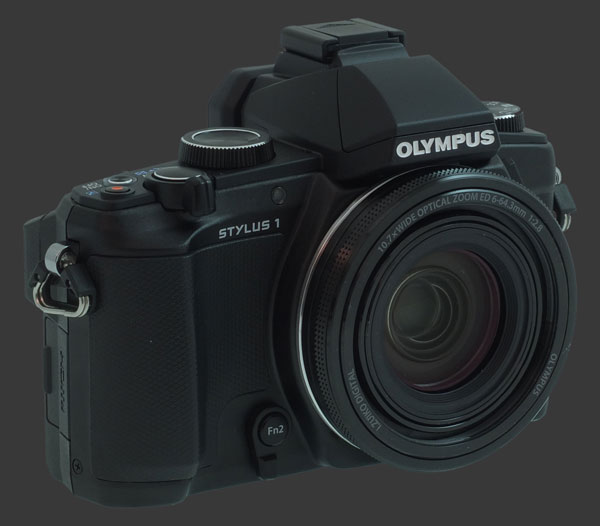
The right-hand thumb rests on a textured rubber patch between the Fn1 and Playback buttons. A slight outward curve helps hold the camera securely. The right neck-strap eyelet though is in an uncomfortable position which can dig into the side of your finder while reaching for the shutter-release.
At the center of the control-ring switch, there is an unusual customizable Fn2 button. Instead of being assigned a function, this one cycles between a number of user-selectable settings: Stabilization, Picture Mode, Scene Mode, Art Filter, WB, Drive, Aspect-Ratio, Image Quality, Video Quality, Flash Mode, FC, Metering, AF Mode, ISO, Face-Priority and ND Filter. This is quite a list! Of course, the more functions are assigned, the longer it takes to cycle around. ISO is clearly an essential choice here.
On the other side of the lens barrel, there is a sliding zoom controller. It moves the lens smoothly. There is a choice of slow or normal speed. While the former takes longer, it is more precise. The other zoom controller, wrapped around the shutter-release, always operates at normal speed.
Every part of the Olympus Stylus 1 feels solid, even the battery compartment cover. The camera feels quite solid without being heavy in use, since both hands tend to support it. Most likely due to the bright aperture and long reach of its lens, the barrel is large for a compact camera. Olympus innovated here by supplying a removable lens cover which opens up to let the lens through which leaves little reason to take it off.
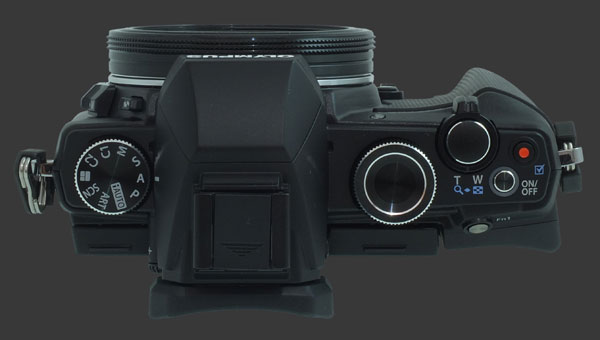
Power on and off require a quick press of the power button which is located on the top-plate. A tiny configurable Video-Record button finds itself at the front-right corner of the camera. Next to it, there is a two-stage shutter-release with a soft halfway point. When the camera takes long to focus, it can therefore happen that a picture gets taken accidentally.
There is a large control-dial with good detents next to the shutter-release. It adjusts Exposure-Compensation or Aperture in Manual exposure mode. The dial is unmarked, so keep an eye on EC while shooting.
The built-in EVF occupies a large housing on the top-plate. On top of it, there is a standard hot-shoe. On the other side of the EVF, there is a traditional mode-dial with 10 positions. The usual 4 PASM modes are there, plus two custom modes, an auto mode along with 3 scene positions. The chosen mode affects the functions assigned to each mode dial. In the case of scene modes, some menu options are often blocked as well.
The behavior of control-dials can be customized by mode. One usually sets an exposure-parameter, while the other sets EC or FC. Program-Shift is available in P and some automatic modes. Too bad Olympus did not allow ISO to be controlled by the rear-dial.
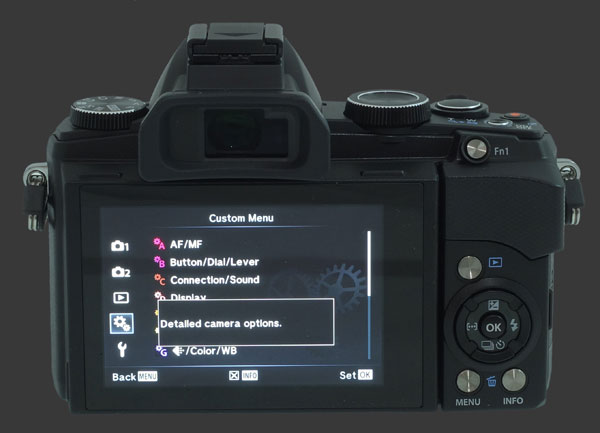
The back of the camera is dominated by a 3" LCD with 1 megapixel. It is really sharp and has nice contrast. The screen is mounted on a sturdy hinge which lets it tilt vertically. It has a good anti-reflective coating that makes it usable in bright light.
Above the LCD is a large 0.44" EVF with 1.15X magnification. Having 1.44 megapixels, it is extremely sharp and clearly shows focus. It has 100% coverage and it paired with a convenient Eye-Start sensor which automatically switches between the LCD and EVF based on proximity. This usability feature is a must-have!
Both displays have a fast refresh-rate. Color and white-balance are previewed quite well. Sadly, the display is only Exposure-Priority in Manual mode. Otherwise, it shows the metered exposure which is obviously only be correct within the latitude of the camera.
To the right of the display are a number of buttons mostly gathered around the combined 4-way controller and rear control-dial. The one exception is a programmable Fn1 button near the top-edge of the camera. It can be assigned one of 8 functions: AE-L, DOF-Preview, One-Touch WB, Focus-Point Home, Digital Zoom, Converter Settings, ND Filter or Zoom Framing Assist. Most of these are obvious. Converter Settings allow to select which optical converter is mounted on the camera. Framing Assist zooms out temporarily to help frame subjects.
The Playback, Menu and Info button works just as they do one most cameras. Each cardinal point of the 4-way controller is labelled with its default function. The central OK button also invokes photographic controls:
- OK: Brings up an icon-based quick menu or an interactive control-panel at the last used position. The top control-dial select what to change and the control-ring changes it. This is extremely efficient.
- Up: Once pressed, vertical buttons change EC ±3 in 1/3 steps and horizontal ones set the current exposure parameter. In Manual mode, the other parameter changes instead of EC.
- Right: Shows the flash options, the ones that do not apply to the current exposure mode appear greyed-out.
- Down: Shows drive mode options including bracketing (BKT) and self-timers. The BKT option is usually greyed-out because this one is only a toggle. Bracketing itself must be configured in the camera's menu.
- Left: Controls focus by first showing the currently active focus-point(s). The rear control-dial or directional buttons can be used to select a single focus point or all of them. At this point the Info button can be pressed to bring up focus-mode options.
For all options activated by the 4-way controller, OK can be pressed to confirm the selection and dismiss the menu. This is not necessary as the selected option is set regardless. The implementation of the directional buttons actually brings up the quick menu at a specific position. So, even though Down activates Drive Mode, the front control-dial can still be used to select other settings to change. When the OK button is pressed to bring up the quick menu, it does so at the last known position even if it was set by one of the directional buttons.
Although the quick menu can be used to change Picture Mode, White-Balance and Image Quality, it cannot be used to configure them. Specifically any adjustments to image parameters such as sharpness, saturation and contrast has to be done through the Super Control-Panel or the menu system. The same is true for WB fine-tuning. Custom white-balance can be set though by pressing the Info button when the Custom White-Balance option is selected.
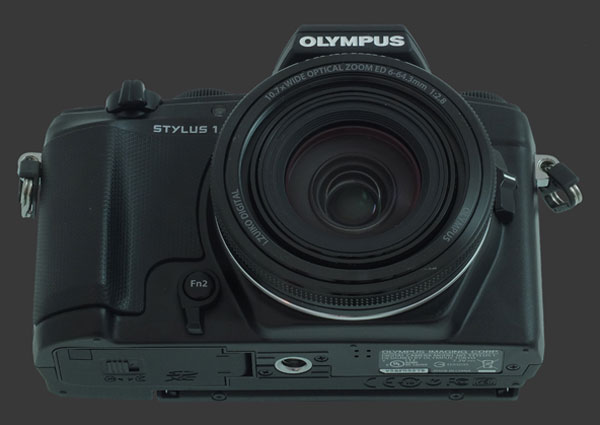
The bottom of the Stylus 1 has a metal tripod mount which is neither inline with the lens nor the center of the camera. It also has a sturdy door which covers the battery and memory-card compartment. The sides of the camera are mostly bare.
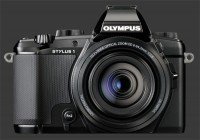 |
Please Support Neocamera
All information on Neocamera is provided free of charge yet running this website is a huge endeavor. Purchases made via affiliate links found throughout the site help keep it running and up-to-date. There is no additional cost to you, so please consider buying via these links to our affilates:
If you found any information on this site valuable and did not purchase via our affiliate links, please considering donating via PayPal:
Any amount will be greatly appreaciated. Thank you for your support!
Olympus 1 Highlights

Sensor-Size: 8 x 6mm

Actual size when viewed at 100 DPI
| 12 Megapixels Ultra Zoom | ISO 100-12800 |
| 10.7X Wide Optical Zoom | Shutter 1/2000-60s |
| Built-in Stabilization | Full manual controls, including Manual Focus |
| 0.44" Built-in EVF 1.4 Megapixels (0.58X) | Custom white-balance with 2 axis fine-tuning |
| Automatic Eye-Start sensor | Spot-Metering |
| 2 Axis Digital Level | Hot-Shoe |
| 7 FPS Drive, 70 Images | Lithium-Ion Battery |
| 1920x1080 @ 30 FPS Video Recording | Secure Digital Extended Capacity |
| 3" LCD 1 Megapixels |
Updates
2024.08.07

Eye Protection Tips for Professional Photographers
The four main considerations for professional photographers regarding eyewear.
2024.07.14

Fujifilm X100VI Review
Flagship fixed-lens compact digital camera with a 40 MP sensor and Image-Stabilization, a first for the series. Retro design featuring dual control-dials, plus direct ISO, Shutter-Speed and EC dials. Its hybrid viewfinder can switch between EVF and OVF mode.
2024.05.09

Fujifilm GFX100 II Review
Flagship 102 Megapixels Medium-Format Mirrorless Digital Camera with 8-Stop 5-Axis IBIS, 8 FPS Drive, 8K Video and 400 MP Super-Resolution capture in a weatherproof and freezeproof body with dual control-dials and dual memory-card slots.
2024.04.03

Fujifilm X-T5 Review
Newest Fujifilm flagship boasting a 40 MP APS-C sensor, 5-axis IBIS with 7-stop efficiency, 15 FPS continuous drive, 6.2K Video capture, dual control-dials and dual SDXC UHS-II slots in a sturdy weatherproof and freezeproof body.
2023.11.20

Best Digital Cameras of 2023
Find out which are the Best Digital Cameras of 2023. All the new Mirrorless Digital Cameras from entry-level to high-end professional.
2023.07.10

Fujifilm X-H2 Review
40 Megapixels APS-C Hybrid Mirrorless Digital Camera with 7-stop IBIS. Fastest shutter ever and 8K video capture. Large builtin EVF with 0.8X magnification and 5.8 MP, plus an Eye-Start Sensor. Packed with features and large number of controls in a weatherproof and freezeproof body.
2023.05.07

Sony FE 20-70mm F/4G Review
Review of the unique Sony FE 20-70mm F/4G lens. The optical zoom of this lens spans ultra-wide-angle and medium focal-length coverage, making it one of the most versatile Full-Frame lenses on the market.
2023.01.15

Huion Inspiroy Dial 2 Review
Review of the Huion Inspiroy Dial 2 tablet, a medium sized drawing surface with dual dials and customizable buttons. Connects via USB-C or Bluetooth 5.0 with Windows, Linux and Android support.
2022.12.08

How to Pack for a Photo Trip
Find out how to pack for a travel photography trip, carry your gear safely while meeting airline regulations.
2022.11.13

Best Digital Cameras of 2022
The best digital cameras of 2022. A short list of the most outstanding models in their respective categories. Choose one for yourself or as a gift.
2022.09.21

Pentax DA* 60-250mm F/4 SDM Review
Review of the Pentax DA* 60-250mm F/4 SDM, the constant-aperture telephoto zoom with the highest zoom-ratio on the market.
2022.09.20

Pentax DA* 50-135mm F/2.8 SDM Review
Review of the Pentax DA* 50-135mm F/2.8 SDM, the lightest professional telephoto zoom native to the K-mount.












